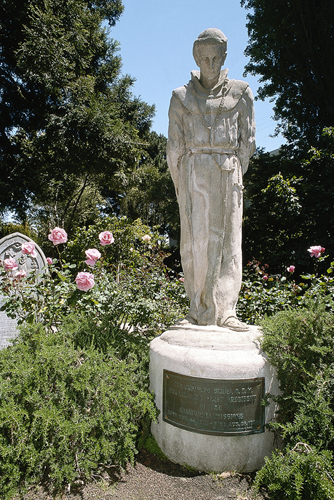Native Americans There
were settlements in the Bay as early as the 11th century BC, made up of
hunters and gatherers who enjoyed a rich diet of seeds, shellfish, and
game. Historians group these peoples into the Coast Miwok, the Wintun,
and the Ohlone. Sir Francis Drake In
1579, the English privateer landed near Point Reyes and claimed Alta
California for Queen Elizabeth I. Along with other early explorers of
the area, he failed to notice the marvelous bay just inside the straits.
England didn’t follow up its claim to Northern California, leaving it
to the Spanish to conquer. Spanish Control About
200 years after Drake’s wanderings, Spain got serious about
establishing a presence in Alta California. In 1776, an expedition led
by Juan Bautista de Anza arrived at San Francisco Bay and established
the Presidio (fort). A mission was also founded by Father Junipero Serra .

Statue of Father Junipero Serra
American Takeover Impending
war with Mexico in the 1840s inspired US leaders to arouse the interest
of Bay Area settlers in joining the Union. In 1846, a party of Yankees
in Sonoma declared California’s independence from Mexico, christening it
the Bear Flag Republic. Shortly after, Commodore John Sloat claimed
California as US territory. Gold Rush Days In
1848 landowner John Sutter noticed a curious glitter in the sediment of
the American River in the Sierra Nevada foothills and realized it was
gold. Despite attempts to keep the discovery quiet, word leaked out, and
businessman Sam Brannan displayed a bottle of gold dust and nuggets for
the whole city to see. The subsequent stampede of ‘49ers turned the
city into a boom town overnight. Wells Fargo Stagecoaches
of Wells Fargo & Co began carrying freight and passengers in 1852,
taking full advantage of the momentum set up by the Gold Rush. It was
also instrumental in the development of the Pony Express . Panama-Pacific Exposition Held in 1915 to celebrate the opening of the Panama Canal, the real raison d’être for the festivities was that San Franciscans had resurrected their city after the 1906 disaster . Bay and Golden Gate Bridges The
Bay Bridge’s inauguration in 1936 heralded the end of the age of
ferryboats by linking the city to the East Bay. The inauguration of the Golden Gate Bridge took place a year later. ”Summer of Love” San
Francisco counterculture burst forth in the summer of 1967. Suddenly,
hippies were everywhere, and the eerie, poetic music that embodied a new
way of thinking filled the air. It was a socio-political shift that
affected the whole world. Senators Feinstein and Boxer California
has always been several steps ahead of the rest of the country. In 1992
it became the first state to send two women Senators to the US
Congress, Dianne Feinstein and Barbara Boxer.
Top 10 Scandals and Disasters
Native Americans’ Near-Extinction In the late 1800s Native Americans were hunted down by settlers, with a bounty paid for each scalp. Gold Rush Lawlessness Gold Rush frontier life was so criminal that vigilante justice was proclaimed in the 1850s, leading to secret trials. 1906 The earthquake and consequent fire devastated much of the city, and 250,000 people were left homeless. ”Bloody Thursday” On July 5, 1934, police fired shots at striking longshoremen, leaving two dead. Howl On October 13, 1955, Allen Ginsberg read his revolutionary poem in San Francisco, which was later banned as obscene. Freedom & Anti-War Pro-Civil Rights and anti-Vietnam War riots occurred from 1964 to 1970 Rock Icons Die Part of hippie legend, Janis Joplin and Jimi Hendrix died in 1970. White’s Revenge In 1978 ex-Supervisor Dan White shot dead Mayor George Moscone and gay Supervisor Harvey Milk. AIDS The AIDS epidemic reached overwhelming proportions in the city in the 1980s. Loma Prieta Earthquake In October 1989, the quake destroyed the Victorian center of Santa Cruz and part of the Bay Bridge.
|